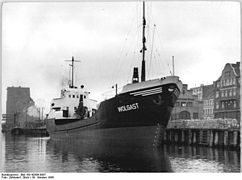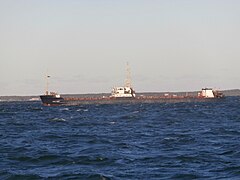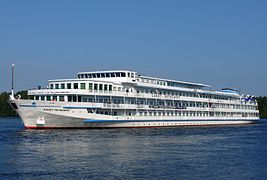Elbe shipyard in Boizenburg
| Elbe shipyard in Boizenburg
|
|
|---|---|
| legal form | 1948–1990 VEB 1991–1997 GmbH |
| founding | April 17, 1948 |
| resolution | December 1998 |
| Reason for dissolution | insolvency |
| Seat | Boizenburg , Germany |
| Branch | shipbuilding |
The Elbe shipyard Boizenburg was a shipyard for the construction of inland waterways and small seagoing vessels in Boizenburg in Mecklenburg-Western Pomerania .
history
1793 to 1933
On May 1, 1793, the ship's carpenter Franz Jürgen Lemm founded a boat building company in Boizenburg. Initially, the shipyard, which employed 14 shipbuilders, manufactured small boats and Elbe barges. In 1839 the Lemmsche Werft began building its first paddle steamer , which was later named Alexandrine . The 45-meter-long and 9.45-meter-wide paddle steamer was launched on October 1, 1840. The ship sailed regularly to Hamburg and back from June 20, 1841 to 1842.
In the 1880s, inland navigation operators increasingly demanded motor-driven freight ships . For this clientele, the Lemmwerft built the motor ship Regina in 1885 . The Hera followed in 1887 , a ship equipped with a Klöckner- Deutz engine (6x130 / 170). In the following year, a two-masted schooner , the Marga , was built at the shipyard , which was launched on June 7th of the same year and which was later given an auxiliary engine.
In 1889 the first German motorboat with a petroleum engine (System Capitaine) was built in Boizenburg. Inventor Emil Capitaine had come only in the spring of the year in the city to test its petroleum engine in the shipyard. Shipyard owner Franz Heinrich Martin Lemm also developed an adjustable propeller for the motorboat. This enabled the motorboat, which took its first test drive in the port on May 30th, to achieve greater maneuverability. In the following years over 30 boats with Capitaine propulsion were built. They were mostly acquired by private owners and were mainly used in the port of Hamburg.
In 1895 the Lemmsche Werft began building the first steel ship.
In 1904 the designer and inventor Emil Capitaine returned to Boizenburg. Here he developed a suction gas motor driven by anthracite gas on behalf of the Lemmschen Werft . The newly developed drive was intended for a port tug , which was launched in the same year and was christened Gasschlepper I. After the imperial marine experts learned of the new type of drive, they had the gas tug come to Kiel for a test drive on the orders of Kaiser Wilhelm II . The test drive on November 21, 1904 was extremely successful. In the following year, the first port tugs, which were 9.50 meters long and had a displacement of 6.8 tons, were put into service in Kiel and Hamburg.
The shipyard remained family-owned until 1917 when it was sold to the Carlo Thomsen banking house. After the sale, the company was incorporated into Norderwerft AG.
In 1921 the Elbe shipyard was merged with the Norddeutsche Union-Werke (Tönning), which went bankrupt in 1925 and became part of the Boizenburger Werft GmbH rescue company.
1933 to 1945
From 1933 the shipyard received numerous armaments contracts. At times there were conflicts between the NSDAP and the main shareholder Siegfried Mahr, who stuck to the employment of two Jewish employees. He was arrested by the Gestapo in 1938 for alleged tax evasion at the Hagenow-Land train station and imprisoned for three months. Mahr committed suicide on September 12, 1938. Thereupon the bank Carlo Z. Thomsen took over the management of the company, which from now on was called Thomsen & Co, Werft, Fahrzeug- und Maschinenfabrik GmbH. The shipyard to the pure was under the direction of Oswald Thomsen and his manager Heinrich Vaessen armor operation , among other body segments of the submarine type VII C , wings for Focke-Wulf - fighters and the end of the war also manned torpedoes made. In addition, the armaments company supplied 300 assault boats , 600 M boats, 1000 pontoons and 20 larger landing craft . On April 29, 1944, the armaments company received the award as a war model company at the annual meeting of the Reich Chamber of Labor in Berlin .
During the Second World War , several hundred Soviet , Polish , French , Dutch and Belgian slave laborers were used in the shipyard . They lived in the company's own camp for foreigners and foreign workers on the Elbberg. The workforce at the shipyard grew to 1,800 by the end of the war, the majority of whom were forced laborers. In August 1944 the foreign labor camp was expanded into a concentration camp sub-camp . The Jewish women and girls imprisoned there had to do forced labor under inhumane working conditions in the shipyard until March 1945.
1945 to 1990
Expropriation and a new beginning
On 1 July 1945, took over Soviet military administration in Germany , the control of the area of the circle Hagenow . They confiscated the companies located in the district, including the shipyard, and installed sequesters . In the following October, the shipyard was placed under the fiduciary management of the Hagenow district. After the expropriation of the previous shipyard owner, decided in August 1946, had been carried out, the state of Mecklenburg took over the Boizenburg shipyard in January 1947. A few months later, on April 17, 1948, the traditional shipbuilding company was converted into a state-owned company and consequently incorporated into the Association of People's Own Shipyards . From then on, the shipyard was called VEB Elbe-Werft Boizenburg .
production
| number of pieces | Ship type |
|---|---|
| 49 | Fishing trawler |
| 51 | Logger |
| 111 | Cooling logger |
| 46 | Freezer ships |
| 27 | Refrigerated motor ships |
| 17th | Collapsible barges |
| 15th | Sea tanker |
| 51 | Workshop ships |
| 15th | Sea tanker |
| 85 | Motor cargo ships |
| 16 | Frost trawler |
| 5 | Faroe cutter |
| 15th | Sea tanker |
| 18th | Iceland cutter |
| 2 | Inland tankers |
| 13 | Containers |
| 49 | Inland passenger ships |
| 8th | Special orders |
| total 567 |
The war had left no significant damage and it was not dismantled. In the first post-war period, the shipyard produced goods for everyday use, such as stoves and wagon wheels. In 1945, as part of reparations payments, the production of 12 fishing boats began. On 16 March 1946, the first was launched instead of after the war and on March 30 fishing boats were sent to the SMAD passed. From the end of March 1946, all non-shipbuilding activities were given up on the instructions of SMAD. After further reparation orders , which included the production of herring loggers and freezer ships worth around 200 million DM, coasters were built. This was followed by motor freight ships for inland navigation , fishing cutters and stern trawlers, which were intended for export and for the VEB Fischkombinat Saßnitz . In 1957 the shipyard exported coasters to Albania and fishing trawlers to Iceland and Cuba .
In 1970 the Boizenburger Werft was merged with the Roßlauer Schiffswerft, which resulted in the VEB Elbewerften Boizenburg / Roßlau . Subsequently, a series of 24 small container ships of the Boltenhagen series were built, which were used in feeder service and coastal traffic. This was followed by very labor-intensive cabin passenger ships, mainly of the Dmitriy Furmanov class , which were supposed to operate on the inland waterways of the USSR . After their completion, the cabin passenger ships were brought to Hamburg . However, due to the low headroom of the Elbe bridges , the top deck had to be dismantled before transport. After the subsequent reassembly in Hamburg, the cabin passenger ships were brought to their locations in the Far East in the USSR in floating docks or with heavy-duty ships. A large number of inland containerized coasters of the type CBK were also built for the USSR . The new, streamlined series production also led to in-house measures such as intensive employee training, the construction of a new shipbuilding hall for sectional construction and the construction of a slipway for ships weighing up to 2,000 t.
In 1979 it was incorporated into the shipbuilding combine .
1990 to 1997
After reunification , the shipyards were separated and Elbewerft Boizenburg GmbH became a subsidiary of Deutsche Maschinen- und Schiffbau AG (DMS AG).
DMS AG was the successor to the Shipbuilding Combine , which coordinated the orders from all shipyards in eastern Germany until 1990. After the subsequent privatization of the DMS AG operations by the Treuhandanstalt , the Petram and Brand group took over the Elbewerft Boizenburg. Because of the insolvency of the main client, bankruptcy was filed in 1997 . On December 19, 1997, the last shell was launched with construction number 234. The EWB 500 container ship was completed at the Sietas shipyard in Hamburg and delivered on April 18, 1998 under the name Gerd Sibum .
Almost 500,000 GRT / GT of ship space were built in the Boizenburg Elbe shipyard. With the bankruptcy of the Elbe shipyard in 1997 and the final closure in December 1998, traditional shipbuilding in Boizenburg also ended.
gallery
Novitas-H ( type EWB 340 ), built in 1995
literature
- Harald Keil (Hrsg.): Technical innovations in inland navigation. 100 years of the shipbuilding company. Springer, Berlin 2001, ISBN 978-3-642933-90-5 .
- Rolf Schönknecht, Armin Gewiese: Inland shipping between the Elbe and the Oder. Steiger Moers, Hamburg 1996, ISBN 978-3-921564-98-1 .
- Heinz Schröter, Rudolf Wulff, Gert Uwe Detlefsen: 200 years Elbewerft Boizenburg. Verlag Detlefsen, Bad Segeberg 1994, ISBN 3-928473-44-1 .
- The Boizenburg shipbuilders. In: Peter Reinhard: From Alban to Zeltz: Inventors, researchers and industrial founders from Mecklenburg-Western Pomerania. Reinhard Thon Verlag, Schwerin 1994, ISBN 978-3-928820-23-3 , p. 15.
Web links
- The day after the bankruptcy of the Elbe shipyard in Boizenburg. In: berliner-zeitung.de. Retrieved October 20, 2016 .
- GDR inland shipping, export ships of the Elbe shipyard Boizenburg , accessed on June 1, 2017.
- Katja Frick: Boizenburg: cultural history of the Elbe shipyard. In: svz.de. Retrieved October 20, 2016 .
- Elbewerft Boizenburg - archive images of construction projects 1974–1991. Retrieved March 23, 2017 (Russian).
- Model of an Icelandic cutter type HRB 54 (Virtual State Museum Mecklenburg)
Individual evidence
- ↑ Karin Wulf: Boizenburg in old views , Volume 1, European Library, Zaltbommel 1997, p. 7.
- ↑ Hans Szymanski: Die Dampfschiffahrt in Lower Saxony and the neighboring areas from 1817 to 1867. European University Publishing, Bremen 2011, ISBN 978-3-867416-78-8 , p. 273.
- ^ The gas power machines at the II. Power and work machine exhibition in Munich 1898. In: Polytechnisches Journal . 311, 1899, pp. 85-88.
- ↑ Heinz Schröter, Rudolf Wulff, Gert Uwe Detlefsen: 200 years Elbe shipyard Boizenburg. Verlag Detlefsen, Bad Segeberg 1994, p. 12.
- ↑ Revolutionary: The gas engine. In: Heinz Schröter, Rudolf Wulff, Gert Uwe Detlefsen: 200 years Elbe shipyard Boizenburg. Verlag Detlefsen, Bad Segeberg 1994, p. 12.
- ↑ Uwe Wieben: People in Boizenburg: Their work in politics and culture, in handicrafts, in the shipyard and in the record factory in the late 19th and early 20th centuries. Akademische Verlagsanstalt, Leipzig 2013, p. 147 f.
- ↑ Excerpts and reports. In: Shipbuilding, Shipping and Port Construction. Journal for the entire shipbuilding and related industries. Anthology 6, part 1. Unions-Verlagsgesellschaft, Berlin 1905, p. 214 f.
- ↑ Heinz Schröter, Rudolf Wulff and Gert Uwe Detlefsen: 200 years Elbe shipyard Boizenburg. Verlag Detlefsen, Bad Segeberg 1994, p. 22.
- ↑ a b Uwe Wieben: People in Boizenburg: Their work in politics and culture, in handicraft, in the shipyard and in the record factory in the late 19th and early 20th centuries. Akademische Verlagsanstalt Leipzig, Leipzig 2013, p. 164.
- ↑ Heinz Schröter, Rudolf Wulff and Gert Uwe Detlefsen: 200 years Elbe shipyard Boizenburg . Verlag Detlefsen, Bad Segeberg 1994, p. 49.
- ↑ a b Alexander vom Hofe: Four princes of Schaumburg-Lippe and the parallel system of injustice . Vierprinzen, Madrid 2006, ISBN 978-84-609-8523-5 , p. 85 ( fu-berlin.de [PDF; accessed April 16, 2018]).
- ↑ Heinz Schröter, Rudolf Wulff and Gert Uwe Detlefsen: 200 years Elbe shipyard Boizenburg . Verlag Detlefsen, Bad Segeberg 1994, p. 47.
- ↑ Uwe Wieben: People in Boizenburg: Their work in politics and culture, in handicrafts, in the shipyard and in the record factory in the late 19th and early 20th centuries. Akademische Verlagsanstalt Leipzig, Leipzig 2013, p. 166.
- ↑ Michael Buddrus (ed.): Mecklenburg in the Second World War. The meetings of Gauleiter Friedrich Hildebrandt with the NS leadership bodies of Gau Mecklenburg 1939–1945. An edition of the meeting minutes. Edition Temmen, Bremen 2009, p. 971 (Note No. 21).
- ↑ Boizenburg (Thomsen). In: offenes-archiv.de. Retrieved April 8, 2018 (PDF).
- ↑ Uwe Wieben: People in Boizenburg: Their work in politics and culture, in handicrafts, in the shipyard and in the record factory in the late 19th and early 20th centuries. Akademische Verlagsanstalt Leipzig, Leipzig 2013, p. 169.
- ↑ Uwe Wieben: People in Boizenburg: Their work in politics and culture, in handicrafts, in the shipyard and in the record factory in the late 19th and early 20th centuries. Akademische Verlagsanstalt, Leipzig 2013, p. 171.
- ↑ Heinz Schröter, Rudolf Wulff and Gert Uwe Detlefsen: 200 years Elbe shipyard Boizenburg. Verlag Detlefsen, Bad Segeberg 1994, pp. 122-142.
- ↑ Heinz Schröter, Rudolf Wulff and Gert Uwe Detlefsen: 200 years Elbe shipyard Boizenburg. Verlag Detlefsen, Bad Segeberg 1994, p. 50.









